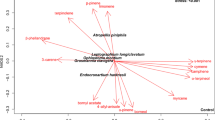Summary
Loblolly pines (Pinus taeda) are rapidly killed by colonizing southern pine beetle (Dendroctonus frontalis). The female beetles carry two species of fungi (Ceratocystis minor var. barrasii and an unnamed basidiomycete) within a mycangium. The insects are also frequently associated with a blue-staining form of C. minor. These fungi are inoculated into the tree during colonization. The tree has an induced defensive response that involves resin soaking and necrosis of affected tissue isolating the invading organlsms. The blue-staining fungus stimulates formation of this response in the tree, but the two mycangial fungi do not. These results suggest that the beetles are closely associated with two highly pathogenic fungi that do not stimulate one of the critical components of tree defense.
Similar content being viewed by others
References
Barras SJ (1973) Reduction of progeny and development in the southern pine beetle following removal of symbiotic fungi. Can Entomol 105: 1295–1299
Barras SJ, Hodges JD (1969) Carbohydrates of the inner bark of Pinus taeda as affected by Dendroctonus frontalis and associated microorganisms. Can Entomol 101: 489–493
Barras SJ, Perry T (1972) Fungal symbionts in the prothoracic mycangium of Dendroctonus frontalis (Coleoptera: Scolytidae). Z Ang Entomol 71: 95–104
Barras SJ, Taylor JJ (1973) Varietal Ceratocystis minor identified from the mycangium of Dendroctonus frontalis. Mycopath et Mycol Appl 50: 293–305
Bridges JR, Nettleton WA, Connor MD (1985) Southern pine beetle (Coleoptera: Scolytidae) infestations without the blue-stain fungus, Ceratocystis minor. J Econ Entomol 78: 325–327
Caird RW (1935) Physiology of pines infested with bark beetles. Bot Gazette 96: 709–733
Craighead RC (1928) Interrelation of tree-killing bark beetles (Dendroctonus) and blue-stains. J For 216: 886–887
Doke N, Tomiyama K (1980) Suppression of the hypersensitive response of potato tuber protoplasts to hyphal wall components by water soluble glucans isolated from Phytophthora infestans. Physol Plant Pathol 16: 177–186
Francke-Grosmann H (1965) Ein Symbioseorgan bei dem Borkenkäfer Dendroctonus frontalis Zimm. Naturwissenschaften 52: 143
Garas NA, Doke N, Kuc J (1979) Suppression of the hypersensitive reaction in potato tubers by mycelial components from Phytophthora infestans. Physiol Plant Pathol 15: 117–126
Graham K (1967) Fungal-insect mutualism in trees and timber. Ann Rev Entomol 12: 105–126
Hemingway RW, McGraw GW, Barras SJ (1977) Polyphenols in Ceratocystis minor-infected Pinus taeda: Fungal metabolites, phloem and xylem phenols. J Agric Food Chem 25: 717–720
Hetrick LA (1949) Some overlooked relationships of the southern pine beetle. J Econ Entomol 42: 466–469
Maclean DJ, Sargent JA, Tommerup IC, Ingram DS (1974) Hypersensitivity as the primary event in resistance to fungal parasites. Nature (London) 249: 186–187
Muller KO (1959) Hypersensitivity. In: Horsefall JG, Dimond AE (eds) Plant Pathology, vol. 1. Academic Press, New York, pp 469–519
Nelson RM (1934) Effect of blue-stain fungi on southern pines attacked by bark beetles. Phytopathol Z 7: 325–352
Nelson RM, Beal JA (1929) Experiments with blue-stain fungi in southern pines. Phytopathology 19: 1101–1106
Paine TD (1984a) Influence of the mycangial fungi of the western pine beetle on water conduction through ponderosa pine seedlings. Can J Bot 62: 556–558
Paine TD (1984b) Seasonal response of ponderosa pine to inoculation of the mycangial fungi from the western pine beetle. Can J Bot 62: 551–555
Reid RW, Whitney HS, Watson JA (1967) Reactions of lodge-pole pine to attack by Dendroctonus ponderosa Hopkins and bluestain fungi. Can J Bot 45: 1115–1126
Shrimpton DM (1978) Resistance of lodgepole pine to mountain pine beetle infestation. In: Berryman AA, Amman GD, Stark RW, Kibbee DL (eds) Theory and Practice of Mountain Pine Beetle Management in Lodgepole Pine Forests. University of Idaho Press, Moscow, ID, pp 64–76
Stephen FM, Paine TD (1985) Seasonal patterns of host tree resistance to fungal associates of the southern pine beetle. Z Ang Entomol 99: 113–122
Wong BL, Berryman AA (1977) Host resistance to the fir engraver beetle. 3. Lesion development and containment of infection by resistant Abies grandis inoculated with Trichosporium symbioticum. Can J Bot 55: 2358–2365
Wright E (1933) A cork borer method for inoculating trees. Phytopathology 23: 487–488
Author information
Authors and Affiliations
Rights and permissions
About this article
Cite this article
Paine, T.D., Stephen, F.M. Fungi associated with the southern pine beetle: avoidance of induced defense response in loblolly pine. Oecologia 74, 377–379 (1987). https://doi.org/10.1007/BF00378933
Received:
Issue Date:
DOI: https://doi.org/10.1007/BF00378933




